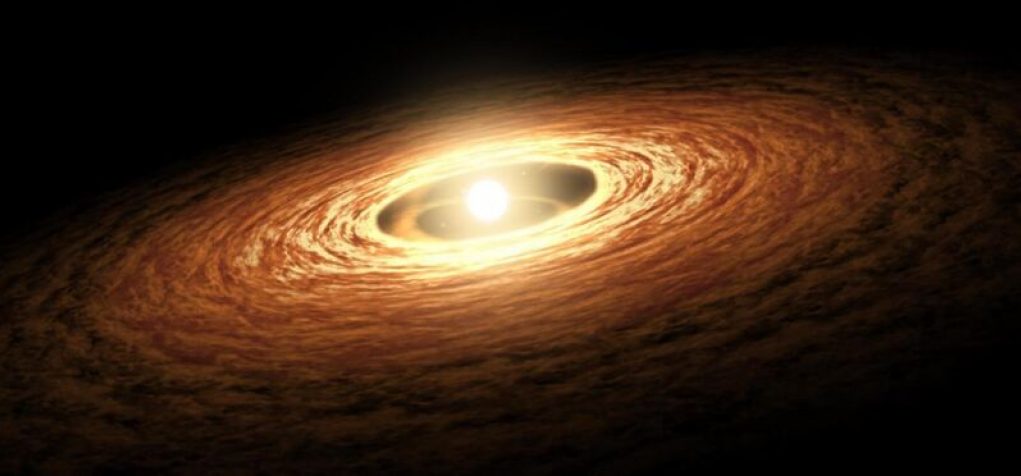Stars are born within massive filaments of molecular gas, and it is in the hubs where these filaments intersect that massive stars come into existence.
These massive stars, located nearby, posed a potential threat to the early Solar System due to the risk of a powerful supernova. This risk is not just theoretical; a team of researchers led by astrophysicist Doris Arzoumanian at the National Astronomical Observatory of Japan discovered possible evidence of a massive star’s explosive demise by analyzing isotopes found in ancient meteorites.
But how did the Solar System manage to survive? It seems that the gas within the filament acted as a shield, protecting the young Solar System from the destructive effects of the supernova and its radioactive isotopes. “The host filament can shield the young Solar System from stellar feedback, both during the formation and evolution of stars (stellar outflow, wind, and radiation) and at the end of their lives (supernovae),” explained Arzoumanian and her team in a recent study published in The Astrophysical Journal Letters.
Indications of a Supernova
The researchers examined meteorites containing small inclusions or lumps that are as old as the Solar System itself. These lumps contain isotopes that result from the decay of short-lived radionuclides (SLRs), which can be produced by supernovae. Although SLRs decay relatively quickly in cosmic terms, they leave behind distinct isotopes.
The team discovered an unusually high level of SLR isotopes in the meteorites they studied. Based on the isotopes’ age, they concluded that these SLRs were present in the early Solar System. While supernovae are one possible source of SLRs, there are other ways they can form.
Advertisement
SLRs from the interstellar medium may already exist in the molecular cloud where a star forms. The birth of massive stars, which have relatively short lifespans in cosmic terms and end in supernovae, can be another source of SLRs. Isotopes produced by highly energetic solar or galactic cosmic rays can also explain the presence of SLRs in the early Solar System.
Although SLRs likely existed in the part of the filament where the Sun and Solar System formed, the meteorite samples contained an excessive amount of a specific aluminum isotope for the interstellar medium to be the sole source of SLRs in the Solar System. Cosmic rays, which can convert stable isotopes into radioactive ones, have a better chance of explaining the abundance of isotopes found in the meteorites. However, this process would have taken too long to produce the levels of SLRs observed in the early Solar System.
It is most likely that the high levels of SLRs originated from either intense stellar winds during massive star formation or remnants of a supernova.
Protection
So why didn’t the supernova disrupt the Solar System? It appears that the molecular gases within the filament where the Sun formed acted as a buffer. If the isotopes from those long-decayed SLRs were indeed from a supernova or stellar winds, the amount that made it through the filament gas was sufficient to match the findings in the meteorites but not enough to devastate the Solar System. The size of this hypothetical supernova or newborn star remains unknown.
“This scenario may have multiple important implications in our understanding of the formation, evolution, and properties of stellar systems,” the researchers added in their study.
Although there are still unanswered questions, scientists speculate that if the clouds within the filament where the Sun and Solar System formed were large enough, our star and planets would have easily survived the impact of a supernova.
The Astrophysical Journal Letters, 2023. DOI: 10.3847/2041-8213/acc849 (About DOIs).
Elizabeth Rayne is a creature who writes. Her work has appeared on SYFY WIRE, Space.com, Live Science, Grunge, Den of Geek, and Forbidden Futures. When not writing, she is either shapeshifting, drawing, or cosplaying as a character nobody has ever heard of. Follow her on Twitter @quothravenrayne.
Solar System’s Survival Linked to Sun’s Formation Amidst Supernova Threat
The formation of the Sun some 4.6 billion years ago was a major milestone in the history of our Solar System – and may also explain why the Solar System has survived till this day, according to a new study.
The study, conducted by researchers at the University of Kent in the United Kingdom, suggests that the Sun may have formed from among the clouds of dust and gas that pre-dated its existence, enabling it to withstand a supernova explosion that would have sent other planets spiraling away.
Supernovae – the explosions that occur when certain stars reach the end of their life cycles – emit a powerful blast of energy. This energy could have been enough to disrupt the orbits of other planets had it been too powerful, sending them into a chaotic state and potentially causing them to be lost to the Universe.
However, researchers believe that the way in which the Solar System formed may have actually enabled it to survive this wave of energy.
The study suggests that due to the formation of the Sun, the gravitational effect of the star caused the dust and gas clouds to form an accretion disk. This disk then began to fill up with bigger clumps of dust, leading to the formation of planets that now orbit the Sun.
The study suggests that these newly formed planets were then protected from the supernova explosions as the clumps of dust were too dense for the energy to penetrate – an effect known as the “shielding effect”. This enabled the planets to remain in their orbits and thus would have allowed them to survive the potentially hazardous blasts of energy.
It is still believed that the supernovae explosions could have caused disruption to the Solar System by scattering planets in multiple directions and thus slowing down the formation of other planets. However, it appears that our Solar System was lucky enough to have been formed and evolved in the protection of dense dust and gas clouds that saved it from a catastrophic end.




















